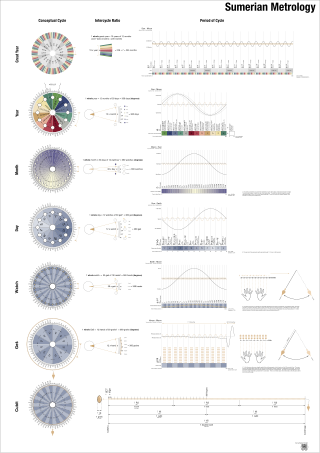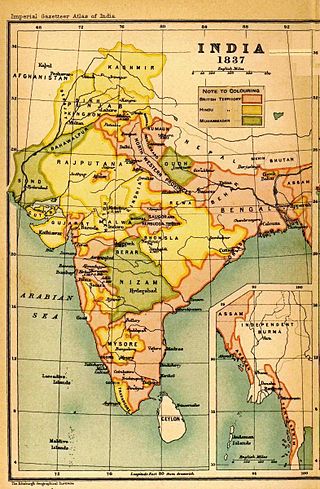
Metrology is the scientific study of measurement. It establishes a common understanding of units, crucial in linking human activities. Modern metrology has its roots in the French Revolution's political motivation to standardise units in France when a length standard taken from a natural source was proposed. This led to the creation of the decimal-based metric system in 1795, establishing a set of standards for other types of measurements. Several other countries adopted the metric system between 1795 and 1875; to ensure conformity between the countries, the Bureau International des Poids et Mesures (BIPM) was established by the Metre Convention. This has evolved into the International System of Units (SI) as a result of a resolution at the 11th General Conference on Weights and Measures (CGPM) in 1960.
The batman was a unit of mass used in the Ottoman Empire and among Turkic peoples of the Russian Empire. It has also been recorded as a unit of area in Uyghur-speaking regions of Central Asia. The name is Turkic, but was also sometimes used for the equivalent unit in Persia. The equivalent unit in British India was anglicized as the maund. The value of the batman varied considerably from place to place.

Ancient Mesopotamian units of measurement originated in the loosely organized city-states of Early Dynastic Sumer. Each city, kingdom and trade guild had its own standards until the formation of the Akkadian Empire when Sargon of Akkad issued a common standard. This standard was improved by Naram-Sin, but fell into disuse after the Akkadian Empire dissolved. The standard of Naram-Sin was readopted in the Ur III period by the Nanše Hymn which reduced a plethora of multiple standards to a few agreed upon common groupings. Successors to Sumerian civilization including the Babylonians, Assyrians, and Persians continued to use these groupings. Akkado-Sumerian metrology has been reconstructed by applying statistical methods to compare Sumerian architecture, architectural plans, and issued official standards such as Statue B of Gudea and the bronze cubit of Nippur.

The earliest recorded systems of weights and measures originate in the 3rd or 4th millennium BC. Even the very earliest civilizations needed measurement for purposes of agriculture, construction and trade. Early standard units might only have applied to a single community or small region, with every area developing its own standards for lengths, areas, volumes and masses. Often such systems were closely tied to one field of use, so that volume measures used, for example, for dry grains were unrelated to those for liquids, with neither bearing any particular relationship to units of length used for measuring cloth or land. With development of manufacturing technologies, and the growing importance of trade between communities and ultimately across the Earth, standardized weights and measures became critical. Starting in the 18th century, modernized, simplified and uniform systems of weights and measures were developed, with the fundamental units defined by ever more precise methods in the science of metrology. The discovery and application of electricity was one factor motivating the development of standardized internationally applicable units.
Traditional Japanese units of measurement or the shakkanhō (尺貫法) is the traditional system of measurement used by the people of the Japanese archipelago. It is largely based on the Chinese system, which spread to Japan and the rest of the Sinosphere in antiquity. It has remained mostly unaltered since the adoption of the measures of the Tang dynasty in 701. Following the 1868 Meiji Restoration, Imperial Japan adopted the metric system and defined the traditional units in metric terms on the basis of a prototype metre and kilogram. The present values of most Korean and Taiwanese units of measurement derive from these values as well.
The pao is a unit of dry measure (mass) which is used in South Asia. The name may come from the Punjabi ਪਾਓ páo, which was a traditional charge of one quarter of a seer per every maund of grain that was weighed, converted into a tax by Sawan Mal. Turner also cites a Sindhi word pāu (پاءُ) meaning a quarter of a seer.

A unit of measurement, or unit of measure, is a definite magnitude of a quantity, defined and adopted by convention or by law, that is used as a standard for measurement of the same kind of quantity. Any other quantity of that kind can be expressed as a multiple of the unit of measurement.

The candy or candee, also known as the maunee, was a traditional South Asian unit of mass, equal to 20 maunds and roughly equivalent to 500 pounds avoirdupois (227 kilograms). It was most used in southern India, to the south of Akbar's empire, but has been recorded elsewhere in South Asia. In Marathi, the same word was also used for a unit of area of 120 bighas, and it is also recorded as a unit of dry volume.
Cavan, sometimes spelled Caban or Kaban) is Filipino unit of mass and also a unit of volume or dry measure.
The dharni is a still used ancient unit of mass, used in Nepal, of about 2+1⁄2 seer. It was divided into 2 bisauli (बिसौलि), 4 boṛi (बोड़ि), or 12 pāu (पाउ). The United Nations Statistical Office gave an approximate equivalence of 2.3325 kilograms in 1966.
Vietnamese units of measurement are the largely decimal units of measurement traditionally used in Vietnam until metrication. The base unit of length is the thước or xích. Some of the traditional unit names have been repurposed for metric units, such as thước for the metre, while other traditional names remain in translations of imperial units, such as dặm Anh for the mile.
A number of units of measurement were used in Honduras for length, mass, volume etc. In Honduras, the metric system was adopted in 1910, and has been compulsory since 1912, under a joint convention between Costa Rica, Guatemala, Honduras, Nicaragua and El Salvador.
A number of units of measurement have been used in Cambodia to measure length, mass, volume, etc. The metric system has been compulsory there since 1914.
Korean units of measurement, called cheokgwan-beop or cheokgeun-beop in Korean, is the traditional system of measurement used by the people of the Korean peninsula. It is largely based on the Chinese system, with influence from Japanese standards imposed following its annexation of the Korean Empire in 1910. Both North and South Korea currently employ the metric system. Since 2007, South Korea has criminalized the use of Korean units in commercial contexts, but informal use continues, especially of the pyeong as a measure of residential and commercial floorspace. North Korea continues to use the traditional units, although their standards are now derived from metric conversions.
A shao in China, shaku in Japan and jak in Korea, is a unit of volume measurement in East Asia. One shao equals 1⁄100 sheng. It is 10 mL (millilitres) in China, 18.04 mL in Japan and 18 mL in Korea. Shao' is also a unit of area equal to 0.033 square meters in Japan and Korea.
The Chinese sheng, called sho in Japan and seung in Korea, also called Chinese liter, is a traditional unit of volume in East Asia. It originated from China and later spread to Japan, the Korean Peninsula, Vietnam and other places. One sheng equals 10 ge or 1/10 dou, though its specific capacity has varied by times and regions. Nowadays, it is 1 liter in China, 1.8039 liters in Japan and 1.8 liters in Korea.
Dou, called to in Japan and du in Korea, is a unit of volume in East Asia. It originated in China and later spread to Japan, Korean and other places. One dou equals 10 sheng or 1/10 dan, is 10 liters in China, 18.039 liters in Japan and 18 liters in Korea.
A dan or shi in China, koku in Japan and seok in Korea, is a unit of volume mainly for grains. It originated in China and later spread to other places in East Asia. One dan is divided into 10 dous or 100 shengs. It is 100 litres in China, 180.39 litres in Japan and 180 litres in Korea.
A Cuo in China or sai in Japan is a unit of volume measurement. One cuo equals 1⁄1000 sheng. It is 1 mL (millilitres) in China and 1.804 mL in Japan.




